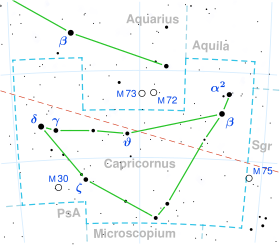Pi Capricorni
| Observation data Epoch J2000.0 Equinox J2000.0 (ICRS) | |
|---|---|
| Constellation | Capricornus |
| Right ascension | 20h 27m 19.21088s[1] |
| Declination | −18° 12′ 42.1980″[1] |
| Apparent magnitude (V) | +5.096[2] |
| Characteristics | |
| Spectral type | B8 II-III[3] or B3-5 V[4] |
| U−B color index | −0.311[2] |
| B−V color index | +0.013[2] |
| Astrometry | |
| Radial velocity (Rv) | −13[5] km/s |
| Proper motion (μ) | RA: +16.914[6] mas/yr Dec.: −16.983[6] mas/yr |
| Parallax (π) | 4.9614 ± 0.3495 mas[6] |
| Distance | 660 ± 50 ly (200 ± 10 pc) |
| Absolute magnitude (MV) | −1.01[7] |
| Details | |
| π Cap Aa | |
| Mass | 5.9±0.1[8] M☉ |
| Luminosity | 238[9] L☉ |
| Temperature | 9,623[9] K |
| Rotational velocity (v sin i) | 30[10] km/s |
| Age | 43.4±7.8[8] Myr |
| Other designations | |
| Database references | |
| SIMBAD | data |
Pi Capricorni, Latinized from π Capricorni, is a triple star system in the southern constellation of Capricornus. It has the traditional star name Okul[citation needed] or Oculus (meaning eye in Latin).[12] This system appears blue-white in hue and is visible to the naked eye as a 5th magnitude star.[2] It is located approximately 660 light years distant from the Sun based on parallax,[6] but is drifting closer with a radial velocity of −13 km/s.[5]
In Chinese, 牛宿 (Niú Su), meaning Ox (asterism), refers to an asterism consisting of π Capricorni, β Capricorni, α2 Capricorni, ξ2 Capricorni, ο Capricorni and ρ Capricorni.[13] Consequently, the Chinese name for π Capricorni itself is 牛宿四 (Niú Su sì, English: the Fourth Star of Ox.)[14]
The primary member, component A, is a spectroscopic binary whose two components are separated by 0.1 arcseconds. The brighter of the two, component Aa, is a blue-white B-type bright giant or main sequence star with an apparent magnitude of +5.08. It is around 43 million years old with six times the mass of the Sun.[8] The star is radiating 238 times the Sun's luminosity from its photosphere at an effective temperature of 9,623 K.[9] The third member, component B, is an eighth magnitude star at an angular separation of 3.4″ from the primary.[15]
References
- ^ a b van Leeuwen, F. (2007), "Validation of the new Hipparcos reduction", Astronomy and Astrophysics, 474 (2): 653–664, arXiv:0708.1752, Bibcode:2007A&A...474..653V, doi:10.1051/0004-6361:20078357, S2CID 18759600.
- ^ a b c d Rakos, K. D.; et al. (February 1982), "Photometric and astrometric observations of close visual binaries", Astronomy and Astrophysics Supplement Series, 47: 221–235, Bibcode:1982A&AS...47..221R.
- ^ Cowley, A. (November 1972), "Spectral classification of the bright B8 stars", Astronomical Journal, 77: 750–755, Bibcode:1972AJ.....77..750C, doi:10.1086/111348.
- ^ Houk, N.; Smith-Moore, M. (1988), Michigan Catalogue of Two-dimensional Spectral Types for the HD Stars, vol. 4, Bibcode:1988mcts.book.....H.
- ^ a b Wilson, Ralph Elmer (1953), "General Catalogue of Stellar Radial Velocities", Carnegie Institute Washington D.C. Publication, Washington: Carnegie Institution of Washington, Bibcode:1953GCRV..C......0W.
- ^ a b c d Brown, A. G. A.; et al. (Gaia collaboration) (August 2018). "Gaia Data Release 2: Summary of the contents and survey properties". Astronomy & Astrophysics. 616. A1. arXiv:1804.09365. Bibcode:2018A&A...616A...1G. doi:10.1051/0004-6361/201833051. Gaia DR2 record for this source at VizieR.
- ^ Anderson, E.; Francis, Ch. (2012), "XHIP: An extended hipparcos compilation", Astronomy Letters, 38 (5): 331, arXiv:1108.4971, Bibcode:2012AstL...38..331A, doi:10.1134/S1063773712050015, S2CID 119257644.
- ^ a b c Tetzlaff, N.; et al. (January 2011), "A catalogue of young runaway Hipparcos stars within 3 kpc from the Sun", Monthly Notices of the Royal Astronomical Society, 410 (1): 190–200, arXiv:1007.4883, Bibcode:2011MNRAS.410..190T, doi:10.1111/j.1365-2966.2010.17434.x, S2CID 118629873.
- ^ a b c McDonald, I.; et al. (2012), "Fundamental parameters and infrared excesses of Hipparcos stars", Monthly Notices of the Royal Astronomical Society, 427 (1): 343–357, arXiv:1208.2037, Bibcode:2012MNRAS.427..343M, doi:10.1111/j.1365-2966.2012.21873.x, S2CID 118665352.
- ^ Abt, Helmut A.; et al. (July 2002), "Rotational Velocities of B Stars", The Astrophysical Journal, 573 (1): 359–365, Bibcode:2002ApJ...573..359A, doi:10.1086/340590.
- ^ "pi. Cap". SIMBAD. Centre de données astronomiques de Strasbourg. Retrieved 2017-05-12.
{{cite web}}: CS1 maint: postscript (link) - ^ Oculus, constellationsofwords, retrieved 2017-05-13.
- ^ (in Chinese) 中國星座神話, written by 陳久金. Published by 台灣書房出版有限公司, 2005, ISBN 978-986-7332-25-7.
- ^ (in Chinese) AEEA (Activities of Exhibition and Education in Astronomy) 天文教育資訊網 2006 年 5 月 13 日 Archived 2011-05-22 at the Wayback Machine
- ^ Mason, Brian D.; et al. (2001), "The 2001 US Naval Observatory Double Star CD-ROM. I. The Washington Double Star Catalog", The Astronomical Journal, 122 (6): 3466, Bibcode:2001AJ....122.3466M, doi:10.1086/323920.
External links
- Kaler, James B. (November 7, 2014), "Pi Capricorni", Stars, University of Illinois, retrieved 2017-05-13.

